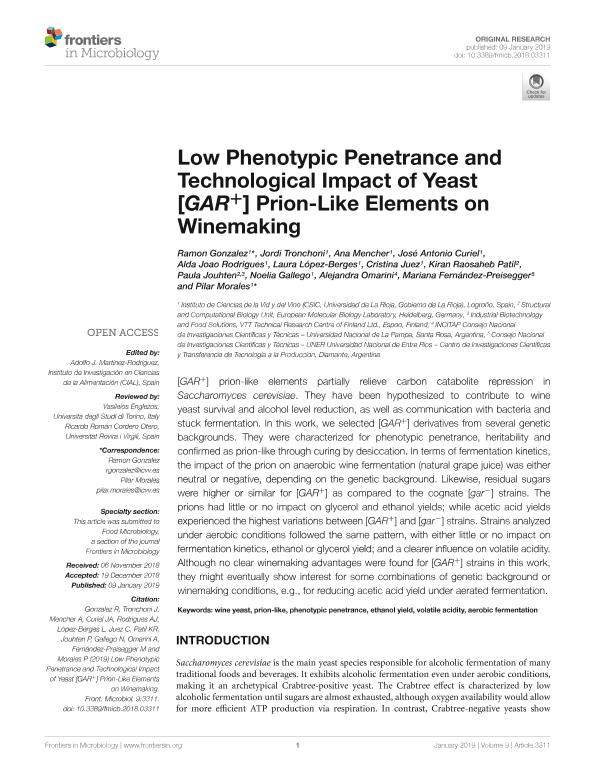Mostrar el registro sencillo del ítem
dc.contributor.author
Gonzalez, Ramon
dc.contributor.author
Tronchoni, Jordi
dc.contributor.author
Mencher, Ana
dc.contributor.author
Curiel, José Antonio
dc.contributor.author
Rodrigues, Alda Joao
dc.contributor.author
López Berges, Laura
dc.contributor.author
Juez, Cristina
dc.contributor.author
Patil, Kiran Raosaheb
dc.contributor.author
Jouhten, Paula
dc.contributor.author
Gallego, Noelia
dc.contributor.author
Omarini, Alejandra Beatriz

dc.contributor.author
Fernández Preisegger, Mariana

dc.contributor.author
Morales, Pilar
dc.date.available
2019-08-12T17:33:29Z
dc.date.issued
2018-12
dc.identifier.citation
Gonzalez, Ramon; Tronchoni, Jordi; Mencher, Ana; Curiel, José Antonio; Rodrigues, Alda Joao; et al.; Low phenotypic penetrance and technological impact of yeast [GAR+] prion-like elements on winemaking; Frontiers Research Foundation; Frontiers in Microbiology; 10; JAN; 12-2018; 1-10
dc.identifier.issn
1664-302X
dc.identifier.uri
http://hdl.handle.net/11336/81456
dc.description.abstract
[GAR+] prion-like elements partially relieve carbon catabolite repression in Saccharomyces cerevisiae. They have been hypothesized to contribute to wine yeast survival and alcohol level reduction, as well as communication with bacteria and stuck fermentation. In this work, we selected [GAR+] derivatives from several genetic backgrounds. They were characterized for phenotypic penetrance, heritability and confirmed as prion-like through curing by desiccation. In terms of fermentation kinetics, the impact of the prion on anaerobic wine fermentation (natural grape juice) was either neutral or negative, depending on the genetic background. Likewise, residual sugars were higher or similar for [GAR+] as compared to the cognate [gar-] strains. The prions had little or no impact on glycerol and ethanol yields; while acetic acid yields experienced the highest variations between [GAR+] and [gar-] strains. Strains analyzed under aerobic conditions followed the same pattern, with either little or no impact on fermentation kinetics, ethanol or glycerol yield; and a clearer influence on volatile acidity. Although no clear winemaking advantages were found for [GAR+] strains in this work, they might eventually show interest for some combinations of genetic background or winemaking conditions, e.g., for reducing acetic acid yield under aerated fermentation.
dc.format
application/pdf
dc.language.iso
eng
dc.publisher
Frontiers Research Foundation

dc.rights
info:eu-repo/semantics/openAccess
dc.rights.uri
https://creativecommons.org/licenses/by/2.5/ar/
dc.subject
Aerobic Fermentation
dc.subject
Ethanol Yield
dc.subject
Phenotypic Penetrance
dc.subject
Prion-Like
dc.subject
Volatile Acidity
dc.subject
Wine Yeast
dc.subject.classification
Biología Celular, Microbiología

dc.subject.classification
Ciencias Biológicas

dc.subject.classification
CIENCIAS NATURALES Y EXACTAS

dc.title
Low phenotypic penetrance and technological impact of yeast [GAR+] prion-like elements on winemaking
dc.type
info:eu-repo/semantics/article
dc.type
info:ar-repo/semantics/artículo
dc.type
info:eu-repo/semantics/publishedVersion
dc.date.updated
2019-08-09T14:32:28Z
dc.journal.volume
10
dc.journal.number
JAN
dc.journal.pagination
1-10
dc.journal.pais
Suiza

dc.journal.ciudad
Lausana
dc.description.fil
Fil: Gonzalez, Ramon. Consejo Superior de Investigaciones Científicas; España. Universidad de la Rioja; España
dc.description.fil
Fil: Tronchoni, Jordi. Universidad de la Rioja; España. Consejo Superior de Investigaciones Científicas; España
dc.description.fil
Fil: Mencher, Ana. Consejo Superior de Investigaciones Científicas; España. Universidad de la Rioja; España
dc.description.fil
Fil: Curiel, José Antonio. Consejo Superior de Investigaciones Científicas; España. Universidad de la Rioja; España
dc.description.fil
Fil: Rodrigues, Alda Joao. Consejo Superior de Investigaciones Científicas; España. Universidad de la Rioja; España
dc.description.fil
Fil: López Berges, Laura. Universidad de la Rioja; España. Consejo Superior de Investigaciones Científicas; España
dc.description.fil
Fil: Juez, Cristina. Universidad de la Rioja; España. Consejo Superior de Investigaciones Científicas; España
dc.description.fil
Fil: Patil, Kiran Raosaheb. European Molecular Biology Laboratory; Alemania
dc.description.fil
Fil: Jouhten, Paula. European Molecular Biology Laboratory; Alemania. Industrial Biotechnology and Food Solutions; Finlandia
dc.description.fil
Fil: Gallego, Noelia. Consejo Superior de Investigaciones Científicas; España
dc.description.fil
Fil: Omarini, Alejandra Beatriz. Consejo Nacional de Investigaciones Científicas y Técnicas. Instituto de Ciencias de la Tierra y Ambientales de La Pampa. Universidad Nacional de La Pampa. Facultad de Ciencias Exactas y Naturales. Instituto de Ciencias de la Tierra y Ambientales de La Pampa; Argentina
dc.description.fil
Fil: Fernández Preisegger, Mariana. Provincia de Entre Ríos. Centro de Investigaciones Científicas y Transferencia de Tecnología a la Producción. Universidad Autónoma de Entre Ríos. Centro de Investigaciones Científicas y Transferencia de Tecnología a la Producción. Consejo Nacional de Investigaciones Científicas y Técnicas. Centro Científico Tecnológico Conicet - Santa Fe. Centro de Investigaciones Científicas y Transferencia de Tecnología a la Producción; Argentina
dc.description.fil
Fil: Morales, Pilar. Consejo Superior de Investigaciones Científicas; España
dc.journal.title
Frontiers in Microbiology
dc.relation.alternativeid
info:eu-repo/semantics/altIdentifier/doi/http://dx.doi.org/10.3389/fmicb.2018.03311
dc.relation.alternativeid
info:eu-repo/semantics/altIdentifier/url/https://www.frontiersin.org/articles/10.3389/fmicb.2018.03311
Archivos asociados
